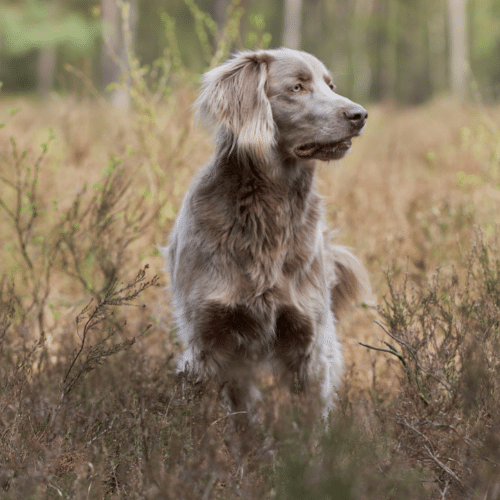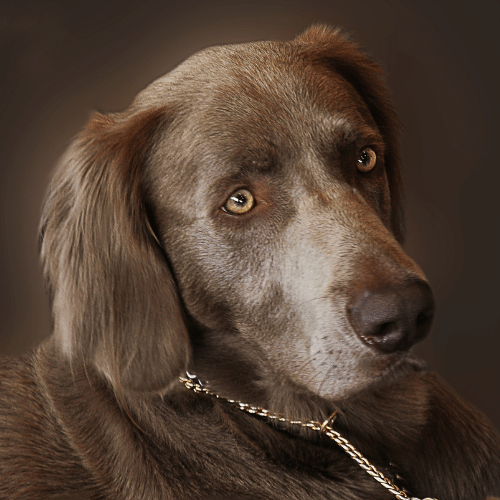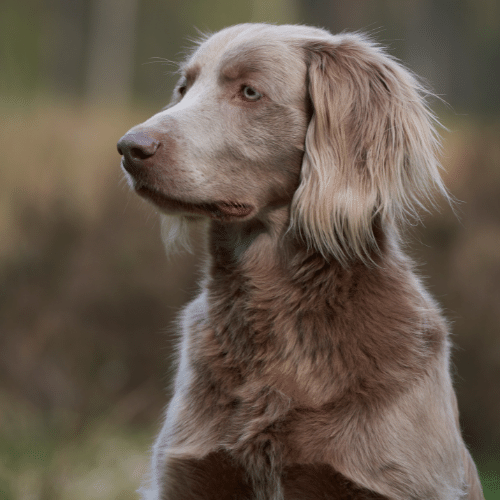Long-Haired Weimaraner – Breed Profile & Information
June 30, 2021 2021-07-08 5:37Table of Contents

Origin & history of the Weimaraner
The Weimaraner, affectionately nicknamed the grey ghost, has two variations, the long-haired Weimaraner and their more populous counterparts, the short-haired Weimaraner. Long-haired Weims are not currently recognized separately from the short-haired variety in the US, and they share the same interesting history.
Originating in Weimar, Germany in the 1800s, Weimaraners were originally bred to track large animals like wolves, bears, and even mountain lions by German royalty. There are two theories about the exact lineage of the breed; one is that they descend from bloodhounds, the other is that they came from the extinct medieval Grey Saint Louis Hound.
Over time, as the popularity of hunting of large animals declined, they were used to hunt smaller animals such as rabbits and foxes. Weims were not known outside of Germany and their numbers were limited due to the royals’ strict breeding program. However, the first Weim club was formed in 1897 to protect the breed. Around this time, the long-haired variety began to appear and they began to be adopted more commonly as companion dogs.
Weimaraners arrived in America and the United Kingdom in 1938. They became increasingly popular in the 1950s due to President Dwight D. Eisenhower and celebrities like Grace Kelly and Dick Clark owning the breed. Weimaraners were recognized by the American and British Kennel Clubs soon after, and several national and local breed clubs were formed.
They remain a popular breed to this day, both in Germany, the US, the UK, and all around Europe. They’re popular as pets, show dogs, and often perform in dog agility thanks to their boundless energy. Their closest doggie relatives are thought to be Bloodhounds and German Pointers.

The long-haired Weimaraner
Whilst it is more common to see the short-haired variety of the Weimaraner, long-haired Weimaraners do exist, and they’re strikingly beautiful! They are recognized separately from the short-haired Weimaraner in most kennel clubs around the world apart from the American Kennel Club. In fact, long hair on a Weim is not in line with the AKC’s breed standard.
Coat length is the only difference between the short and long-haired variety. In dogs, fur length is controlled by a gene called FGF5. Long hair is a recessive genetic trait in Weimaraners, which means that both doggie parents need to have it in order to pass it on to their offspring.
Breeding & puppyhood
Pregnancy and birthing problems are not too common in Weimaraners, thankfully. That said, all breeders should familiarise themselves with issues such as dystocia, or difficult birth, just in case. Weimaraners tend to be born into litters of 6-8 puppies. They usually grow to their full, adult size at around 6-8 months old and are considered mature at around one year of age.
Appearance
Long-haired Weimaraners are a medium-large breed of dog. The average male stands at 23-28 inches tall and weighs 66-88 lb, and the average female is around 22-16 inches tall and weighs 55-77 lb.
They are athletically built with striking grey or amber-colored eyes, long snouts, and large, floppy, triangular-shaped ears. They also have long bodies, long legs, and long, feathery tails.
Long-haired Weimaraner fur is 2-5 cm long and can be straight or wavy. Their coats are a distinctive grey color and can be a few different shades of grey, including brown-grey, silver-grey, or even a blue-grey color. They don’t typically have markings because they are all one color, but some dogs may have patches of lighter fur on their faces, stomachs, and feet.

Personality
Long-haired Weimaraners are very high-energy, playful, intelligent dogs due to their working DNA. They require a medium-large home, lots of physical exercise, and lots of mental stimulation to curb boredom and anxiety.
They are especially prone to separation anxiety, because, despite their tough-looking exterior and fearless nature, they are incredibly soft dogs that long to be with their loved ones at all times.
Weimaraners are very faithful, loving, and protective of their owners and families. They can be aloof with strangers until they get to know them, but are generally friendly and tend to get on well with other dogs following early socialization.
However, without early socialization, they can be aggressive, particularly towards dogs of the same sex. They are also not well-suited to families with cats and other small pets because of their hunting background.
Do long-haired Weimaraners make good family dogs?
Long-haired Weimaraners love family life and make lovely family dogs. They like to be involved in all aspects of family life and should get on well with other family dogs with early socialization. However, they don’t typically get on well with cats and other small pets.
They also may not be best-suited to families with little children under the age of 5 or 6 who are easily knocked over because of their size and energy level. Any parents looking to get a Weimaraner should teach their children how to interact with a dog.
Being kind and gentle is the most important thing; so no shouting, teasing, or pulling on whiskers and tails. Children should also be taught how to approach dogs for their own safety. They should be taught to always let unfamiliar dogs come to them and to never approach unfamiliar dogs when they are eating. Family dogs should also not be approached when eating unless you have a strong bond. Even then, some never grow out of resource guarding behaviors.

What is nooking in Weimaraners?
So-called nooking is a behavior often considered to be unique to Weimaraners. It is when a dog kneads and sucks on their beds and soft toys. Opinions differ on exactly where the behavior stems from; premature separation from mothers, a symptom of anxiety, or just a stress-busting/comfort mechanism that runs in the Weimaraner DNA. It’s likely to be the latter, as it’s often observed before going to sleep.
Whatever the cause is, it’s a common behavior in Weimaraners, and whilst it may seem strange, it’s nothing to worry about and is not the same thing as destructive chewing. It’s actually quite sweet!
Training
Weimaraners are clever and obedient dogs, but training sessions should be kept concise and fun to avoid boredom and stubbornness in young Weims. Owners should also start training their Weimaraners as early as possible and spend time building a bond to make them eager to please.
Positive reinforcement should always be the dominant force. The use of a behavioral marker before a reward like a clicker will speed up the learning process. Negative signals such as the word “no” should be used consistently with a negative association, like being ignored, to become effective.
Areas that Weimaraner owners may need to particularly focus on include impulse control and socialization. Impulse control is exactly what it sounds like; improving the control your dog has over his natural impulses, such as chasing animals.
This should be a priority for owners of Weimaraners because of their hunting backgrounds; they are prone to taking off and chasing animals, and this could lead to dangerous situations such as getting lost or getting in traffic accidents.
You can improve impulse control by practicing recall and playing waiting games, particularly games that involve waiting for food. For more tips on impulse control training, visit our page on improved impulse control.
Socialization should also start as early as possible. It can be done at home by inviting close friends, family, and their dogs over to meet your pup. You should also try to interact with as many friendly dogs as possible on walks.
How much exercise does a long-haired Weimaraner need?
A puppy generally needs 5 minutes of exercise per month of their age. However, an adult Weimaraner needs at least two hours of physical exercise a day, preferably split into two walks. It’s best to keep walks varied by going to different places and incorporating different things into them, such as hiking, running, swimming, and games of fetch.
These dogs remain active into old age, but their exercise routine should become lesser as they get older and slow down. Vets will usually give you an indication of when this is necessary at annual check-ups.

Feeding long-haired Weimaraners
A puppy Weim should eat 20g per 1kg of their weight per day. An adult Weim should eat 2.5 – 3.5 cups of food per day, ideally split into two meals, depending on their exact size, age, and activity level.
Their diet should consist of a high-quality kibble that gives them complete and balanced nutrition, and natural sources of lean protein like chicken and fish to support their slim, muscular frames and high activity level.
Weims should also eat nutritious, fiber-rich fruits and vegetables to support their digestion and overall health. Owners should avoid low-quality commercial dog foods that contain unnatural additives and filler ingredients like grains that are hard for dogs to digest.
Grooming long-haired Weimaraners
Long-haired Weims should be brushed with a bristle brush at least once a week to remove debris and tangles. They’re average shedders, but brushing should be done more regularly during shedding seasons – at the start of summer and winter – to remove loose fur and stop it from getting all over your home.
Their coats don’t require regular baths, although their feathery legs and feet should be cleaned after getting particularly muddy on walks. Some feathery areas may also require the occasional trim for hygiene reasons, and owners should clean their Weims ears once a week with vet-approved solution, as floppy ears are prone to trapping dirt.
Vets will recommend nail clipping if they think it’s necessary, but generally, nails can be kept at a healthy length by going for regular walks. Owners can buy doggie toothbrushes and toothpaste for their dog’s dental health, and teeth can also be kept clean by providing a healthy diet and good chew toys.

Separation anxiety & long-haired Weimaraners
Separation anxiety is when a dog feels intense anxiety when you are away from them. It can result in excessive barking and destructive behaviors towards themselves and the home. Weimaraners are naturally clingy, emotionally dependent dogs, so they are more inclined to experience separation anxiety. Therefore, they aren’t a suitable breed for solo owners who work full-time.
However, even for owners that do spend a lot of time at home, it’s not realistic that you will be able to spend every waking moment together. So, separation anxiety should be tackled to make your Weimaraner feel confident and happy being home alone.
The first step is to leave as little room in their lives for anxiety as possible by sufficiently exercising their bodies and minds. You should also try to involve your dog in family life as much as possible and encourage solo play to show them that being alone is not a bad thing. You can do this by investing in an interactive toy, such as a treat dispenser.
Owners should leave their Weimaraners alone for small periods of time, starting early on in their puppyhood, and gradually increase the time that you are gone. This reassures them that you will always come back and slowly builds their independence.
Never make a big deal out of leaving, but always make a big fuss of them when you come back. This reinforces that something positive is coming for them when you leave. When you go, give them something that creates a positive association with your separation. A treat dispenser toy is best because it will occupy their mind whilst you are gone.
However, don’t leave a puppy with anything with removable parts or anything that is breakable, as it could cause a choking hazard, particularly if your dog is destructive with their separation anxiety at first. Instead, try a treat or a special toy that they only get when you go out.
There are also a number of anti-anxiety pet products on the market that you could use to help you out, such as herbal supplements, plug-in diffusers, and anti-stress toys.
If your dog is destructive at first, try leaving them confined to a specific area of the house that is safe and less destroy-able. You could use a cage or invest in a dog gate to corner off areas that you don’t want them going in or out of. When they make a mess, do not react angrily as the attention actually encourages them. Instead, show them that this kind of behavior doesn’t get any attention.
Boredom & long-haired Weimaraners
As mentioned above, Weimaraners are extremely prone to experiencing boredom when their needs are not met. This is because they are high-energy, highly intelligent, and very sociable dogs. Even if all of their exercise needs are met, they can still experience boredom if their minds are not being challenged regularly.
Boredom can result in similar destructive behaviors to separation anxiety, such as destructive chewing and excessive barking. Owners of Weimaraners should engage in fun, challenging games such as hide and seek with their dogs on a regular basis. They also love to play games that exercise their natural herding instincts, like fetch and chase.
Weimaraners benefit from having some mentally stimulating toys like puzzles, treat-dispensers, and slow feeders. The pet brand Outward Hound is renowned for their brilliant mentally stimulating toys.

We particularly recommend their “Hide A” toys, including Hide A Squirrel, Hide A Bee, and Hide A Hedgehog. They come with a plush log and three squeaky animal plushies to hide inside of it, for dogs to find to retrieve. Not only is this a challenging puzzle, but it also exercises those natural hunting instincts.
Snuffle mats are also a great choice for Weimaraners for the same reason. They are mats with a grass-like texture that you can hide food in, encouraging dogs to use their foraging instincts.
Sensory toys that stimulate the senses by lighting up, changing color, making different sounds, and providing different textures are a good choice for young Weims for whom puzzle toys might be too advanced and older Weims that aren’t as sharp as they used to be.
Another great way to engage your Weimaraner’s brain is by teaching them new tricks. If you’re struggling with ideas, check out our training courses for dogs.
Long-haired Weimaraner health problems
Weims have an average lifespan of 11-14 years. They are generally healthy dogs, but all breeds are naturally prone to certain conditions. Common health conditions among the breed include hip and elbow dysplasia, gastric torsion, distichiasis, hypothyroidism, and mast cell cancer. The AKC recommends that all Weimaraner pups be tested for dysplasia as well as receive a thyroid evaluation and an eye exam.
Dysplasia
Hip dysplasia and elbow dysplasia are congenital conditions that cause the hip or elbow joints to form abnormally. It makes them become loose and wobbly over time and eventually leads to arthritis. There is no cure for either type of dysplasia but both can be managed. Early diagnosis can also delay the condition from getting worse.
Mild dysplasia can require lifestyle changes and non-surgical therapies, whilst more severe dysplasia may require surgery to correct the joint. Either way, dogs with dysplasia should go on to lead long and happy lives.
The symptoms of dysplasia include:
- Limping or bunny hopping
- Difficulty with activities such as jumping and climbing
- Whining and licking the affected joints
- Loss of muscle mass
- Exercise intolerance
- Low mood, sometimes irritability
- Inability to get comfortable
Gastric torsion
Gastric torsion, or bloat, is when the stomach fills with gas. It’s common in deep-chested breeds like Weimaraners and is extremely dangerous because it can twist the gut in a way that cuts off its blood supply.
It’s a life-threatening emergency, so dogs suspected of having gastric torsion must be taken to the nearest emergency vet hospital immediately. Life-saving treatment for gastric torsion includes stomach pumping, IV fluid treatment, antibiotics, painkillers, and surgery.
The symptoms of gastric torsion include:
- A hard, swollen, painful stomach
- Retching
- Drooling
- General distress
Distichiasis
Distichiasis is when extra eyelash hairs grow on the inside of the eyelid and rub on the surface of the eye, it is thought to be hereditary. It is not uncommon, quite treatable, and is easily diagnosed with an eye exam. Although, most dogs with the condition don’t experience pain or irritation and won’t need treatment. Those that do can usually be treated at home with daily eye medicine. In extreme cases, surgery may be required.
The symptoms of distichiasis include:
- Excessive blinking
- Squinting
- Inflammation and irritation
- Discharge
- Tears
- Pawing at the affected eye
Hypothyroidism
Hypothyroidism is a condition in which the thyroid gland doesn’t create enough of the thyroxine hormone. It can cause internal systems such as the digestive system to slow down. In most cases, the causes are unknown.
Diagnosis can be tricky, as there are several conditions that mimic hypothyroidism. Vets may take multiple blood tests before arriving at a diagnosis. Dogs diagnosed with the condition will be prescribed thyroxine and have to take it for the rest of their lives, but it shouldn’t otherwise affect their lives.
The symptoms of hypothyroidism in dogs include:
- Lethargy
- Low mood
- Weight gain & obesity
- Intolerance to cold and exercise
- Increased shedding or hair loss
- Thickening of the skin
Mast cell cancer
Mast cells in dogs are the cells that treat inflammation and allergic reactions in the body. The cancer of mast cells is one of the most common types of cancer in dogs. It has no apparent single cause. Fortunately, the majority of tumors are localized and curable. However, sometimes they do spread to other locations, both on the skin, and internally. Some tumors are also in inoperable places.
They look much like the harmless lumps that occur on dogs’ skin as they age, which is why it’s important to regularly check your dog for new lumps ask your vet to check them all at annual check-ups.
Diagnosis can be made via needle aspiration of the tumor. Surgery is almost always performed to remove the tumor, and at the same time, a biopsy sample will be taken to grade the severity of the cancer. Several bodily tests will be done to determine whether cancer has spread, and radiotherapy is an option for patients will tumors that can’t be removed.
Chemotherapy is also recommended for grade 3 tumors, if there is evidence of spread, or if the tumor can’t be removed. In these cases, the life expectancy is around 20 months.
Early mast cell cancer may have no symptoms other than the visible lump. Symptoms of more advanced Mast cell cancer or cancer that has spread can include:
- Decreased appetite
- Increased breathing
- Lethargy
- Pale gums
- Vomiting or vomiting brown particles
- Dark stool or diarrhea
- Collapse

The cost of long-haired Weimaraners
The average cost of a long-haired Weim is currently between $1500 – $2000 in the United States. This is a little more expensive than a short-haired Weim as they’re much rarer. The exact price tag will depend on a few factors; the first being the breeder.
The breeder you buy from will affect the cost of your Weimaraner pup more than anything else. Buying a puppy from a large, commercial breeder will usually be cheaper than buying a pup from a hobby or small-time breeder. However, a higher price tag often means a better quality of care. In fact, the smaller the breeder, the better quality of care they typically provide.
The Weim’s lineage and coat color can also affect the price. Those that are bred from show dogs or those that compete in agility trials, for example, will have a much higher price tag than those bred from companion Weims.
As mentioned above, Weims come in a few different shades, and some are rarer and more unique than others. Blue Weims, for example, are rarer than grey ones, and this can reflect in the price tag.
Rescue Weimaraners cost the rescue shelter’s adoption fee. This can be anywhere from fifty dollars to a few hundred dollars. Their fee will depend on the size of the adoption center and whether they’re a generic or a breed-specific shelter.
The adoption process is fairly simple, starting with an application form in which prospective owners must submit a few personal details to the shelter and let them know which dog they want to adopt. If the application is approved, they will be invited to meet the dog in person, and the shelter will carry out an inspection of their home to ensure that it is suitable before finalizing the adoption.
Looking after an adult Weim is said to cost around $1000 per year. This is broken up into medical expenses including vet bills and pet insurance, food and treats, toys, grooming supplies, and accessories.
During the dog’s first year, it will probably cost more as they will likely go through a few beds, toys, and collars, as they grow and teethe. Your ownership may also get more costly as your Weim ages and encounters more health problems. The average lifetime cost of owning a Weimeraner is around $17,000.
The bottom line
Long-haired Weimaraners are rare, uniquely beautiful dogs with an interesting history. They need owners and families that are willing to provide lots of companionship, lots of daily exercise, and lots of fun and games.
If you’re interested in owning a long-haired Weim, please remember to buy from an ethical breeder with a good reputation or adopt from a rescue center.
Laura is a dog-lover with an animal-related degree and plenty of hands on experience. She is passionate about dog health & welfare and wants to arm owners with all of the essential info they need!


